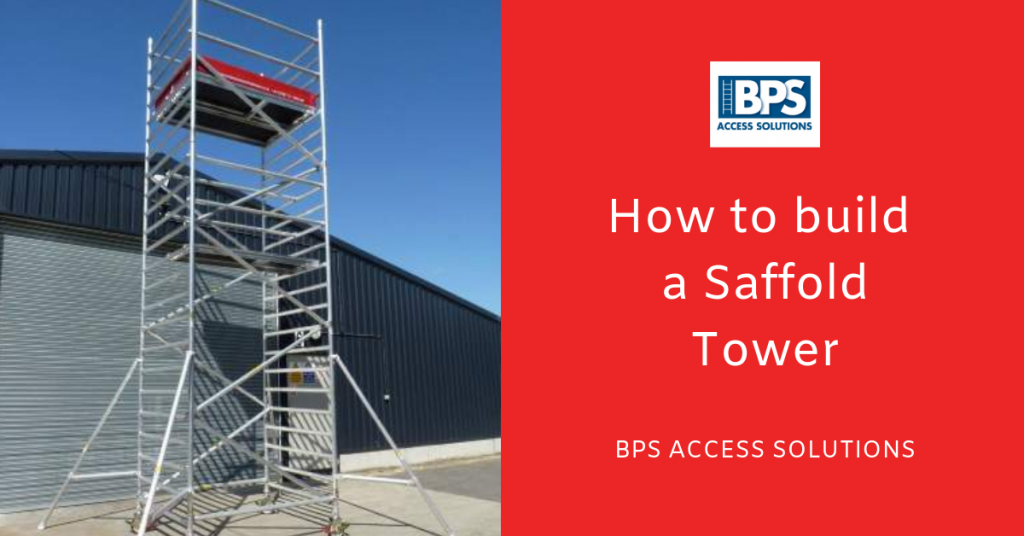How is scaffolding erected?
While many smaller scale home repair or improvement jobs require nothing bigger than a ladder or podium steps, for a larger or more time consuming job a scaffolding tower is the ideal choice for both safety and convenience. For example, outdoor domestic repairs that require working at height, large painting or decorating jobs, pruning tall trees in the garden and many similar jobs would be far more tiring, inconvenient and dangerous without the use of scaffolding. The use of a static scaffold tower gives a far more stable work area and a greatly increased reach to complete the job in a far shorter space of time with less need to move and reposition. The increased space also allows the user to keep tools and materials to hand without having to climb up and down each time something new is required.
One main reservation for those considering using scaffolding at home is the idea that scaffolding is difficult to erect or requires specialist knowledge or tools. However, with the range of aluminium scaffolding towers for homeowners currently on the market this could not be further from the truth. Aluminium, while being strong and hardwearing, is a very light material and a four metre tower with two platforms can easily be erected by one person in under three minutes. For an example of this see https://youtu.be/9WWOTBxda-c . Plastic locking joints are used, allowing the scaffolding to be erected quickly and simply without the need for additional tools. It is vital when learning how to assemble scaffolding that the manufacturers instructions are followed to the letter and no other tools or improvised parts are used. This is the first key point of scaffolding safety and if not followed can lead to disaster for the user.
Before starting to build the tower several factors must be taken into account, each as important as the construction itself. If in doubt on any of these points, do not begin construction until the problem has been addressed.
Check all components
If any are worn or damaged, they must be replaced. Do not take a chance or attempt to jury rig a replacement. Each connection is as important as the rest for structural integrity of the scaffold. In particularly cold weather be sure to remove any ice or snow that could cause slips from any platforms or ladder treads.
Check the ground surface
Make sure the surface is strong enough to support the weight of the tower. Excessively soft or waterlogged soil should be avoided at all costs. On a hard surface remove any loose debris that could cause the base to slip. Make sure you are on a level surface and If in doubt use a spirit level. The scaffolding towers we are about to discuss have adjustable end pieces to counter this but use a spirit level to ensure the platform is level after adjustment to eliminate any risk.
Check for obstructions
As well as making sure no ground obstructions are present, always check above for obstructions such as tree branches or power lines. These are easy to miss but due to the conductive nature of Aluminium, contact with power lines can have fatal consequences. Also make sure to check for these whenever the scaffolding is moved.
Observe wind conditions
If there is wind strong enough to raise twigs and loose debris from the ground it can be extremely hazardous to be on a raised lightweight platform. Also be aware of the funnelling effect of surrounding buildings to create a wind tunnel. If this should occur while you are using the scaffolding, descend immediately and secure the scaffolding to a secure structure until it is safe to dismantle.
Once these issues have been taken into account and the user is sure it is safe to erect the scaffolding, construction can begin. The scaffolding towers discussed below are designed to be erected straight from the packaging without any tools needed. Clear instructions are included and several components are even colour coded to make them easier to identify. Provided the instructions are followed correctly, construction is simple for even the least experienced user.
BPS Access Solutions offer a range of three different grades of DIY scaffolding towers depending on budget and the scale of the job to be undertaken. All are constructed within the EU and conform to the prestigious ISO2001 Standard of quality assurance. It is always advisable to buy from UK or EU manufacturers as the safety standards are far higher than cheaper Asian alternatives, providing a safer product and peace of mind for the consumer. All metal parts are made from Anodised Aluminium, a non corroding metal that will not rust even when used or stored outside regardless of weather, unlike cheaper steel alternatives offered by some suppliers. The platforms are constructed from non slip marine plywood which is similarly weather proof. Obviously, this keeps maintenance to a minimum and extends the working life of the product, making it far more cost effective in the long run.
The Home Master, Premium and Premium Plus ranges all share the same 40mm diameter Aluminium frames which simply slot together for the basic frame. One side forms an integral ladder with ribbed non slip rungs as part of the structure to simplify construction. Colour coded braces are simply attached to the outside of the frame, increasing working space within the structure. Platforms can then be simply slotted into place at the chosen height and are secured by four sturdy red plastic clips. These can be attached at 300mm increments meaning platforms can be placed at the desired height for the job in hand with the minimum of effort and be easily removed and reattached without dismantling the outer frame. The platforms also incorporate a fixed hatch which drops back into place when not in use so they can be fitted as one piece and give the maximum floor space to work on.
Each model is equipped as standard with stabiliser bars at the base to increase the footprint of the structure and give greater stability and all can be fitted with optional soft ground anchoring spikes to give extra grip on soft or grassy surfaces. All ranges are available in four sizes, from four to seven metres in height although all can be part constructed for work at lower heights while end height adjustment allows construction over steps. This is particularly useful for jobs such as decorating tall stairwells or external maintenance where outside staircases are an obstacle. Six and seven metre models come with outriggers as standard to give the extra stability needed for a taller structure but these can also be purchased separately if required. Each of our scaffolding towers comes with wheels for ease of movement. In the case of the Home Master and Premium these are the ‘tilt and glide’ variety of fixed wheel that allow the tower to be moved when tipped back slightly whereas the Premium Plus has larger rotating wheels that can be upgraded to adjustable height wheels to counter sloped or uneven floors.
All our products come with a lifetime guarantee and replacement scaffolding parts are available with just a telephone call. We check our prices against our competition daily to offer the best possible price for our customers and many of our products are unique to BPS so we can guarantee the best quality. If you have any further queries or need advice on the best equipment for your next project, please do not hesitate to contact us. Our experienced, friendly staff will be happy to help.
Website: www.laddersandscaffoldtowers.co.uk
Telephone: 0333 006 9776
Email: sales@bpsaccesssolutions.co.uk
No related posts.



